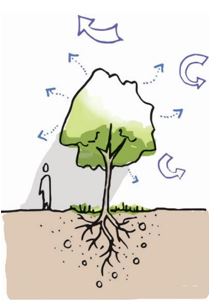Cooling trees are appropriate at different scales:
- the isolated tree: in a park, a street or in a square;
- rows of trees along a street: on either side of a street, on one side of a street or in a central row; and
- at the scale of a city: forming what is called an urban forest.
In terms of mitigation, trees contribute to carbon sequestration through photosynthesis, which transforms carbon dioxide into organic matter. This stored carbon is found:
- in the above-ground biomass: stems, stumps, branches, bark, seeds, foliage or dead wood;
- in the underground biomass: living or dead roots; and
- at the soil level: decomposition of litter (dead leaves and plant debris) or root exudates.
The tree stores carbon as soon as the inflow of carbon resulting from the photosynthesis process is greater than the outflow of carbon (autotrophic respiration of the tree, heterotrophic respiration of decomposers and other micro-organisms in the dead tree and in the litter).

Mechanisms involved in cooling: shading (grey flat), evapotranspiration (dotted arrow). On the other hand, the wind resistance of the tree (curved solid arrow) reduces the air speed (hence a cooling effect that can be neutral or even negative at night).
In terms of adaptation, trees provide a cooling effect. This temperature-reducing effect is due to shading and evapotranspiration, which is the loss of water through evaporation and transpiration that contributes to humidifying the air, and therefore cooling. On the scale of the city and the street, the cooling tree therefore helps to reduce the urban heat island effect. At the pedestrian scale, cooling trees improve comfort during the day, but at night, the effect of trees is neutral, or even negative, because of the obstacle that trees can represent in relation to the wind (particularly for a large tree cover).
Cooling tree also have co-benefits, particularly in terms of biodiversity and well-being. But the pollens of certain trees (e.g. birch, chestnut, olive, cypress) cause certain allergic reactions. A supply of water is also essential for the tree to become an air conditioner.
It should be noted that the impacts in terms of mitigation and adaptation, as well as the co-benefits described above, depends on the choice of species and their spatial organisation.
Comments ()